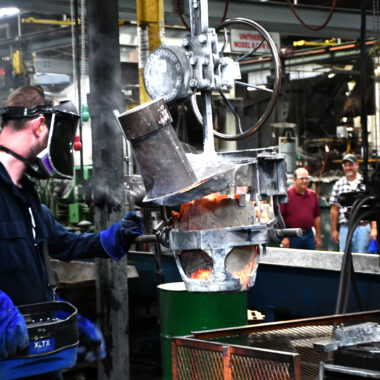Revealing the Creativity: Comprehending About Aluminum Casting
Revealing the Creativity: Comprehending About Aluminum Casting
Blog Article
Crafting Perfection: Exactly How to Attain High-Quality Light Weight Aluminum Castings Whenever
In the world of aluminum casting, the search of excellence is a continuous journey that calls for a thorough technique and a keen understanding of the intricacies entailed. Accomplishing consistent premium aluminum spreadings demands a comprehensive understanding of the processes, from selecting the appropriate alloy to implementing exact mold layouts and carefully controlling casting criteria. The real mastery exists in the ability to carry out these elements effortlessly to create perfect spreadings every time. As we check out the details of crafting perfection in light weight aluminum spreadings, discovering the vital methods and techniques that bring about impeccable outcomes comes to be critical for those pursuing excellence in this specific area.
Understanding Aluminum Casting Processes
Aluminum casting processes, crucial in the manufacturing market, entail the complex makeover of molten aluminum right into solid forms through a collection of meticulously regulated steps. Understanding these procedures is paramount to achieving premium light weight aluminum castings regularly - about aluminum casting. The main methods used in aluminum spreading are pass away spreading, sand casting, and investment spreading

Each of these processes has its advantages and is selected based on elements like complexity, volume, and desired finish of the aluminum spreading. about aluminum casting. Recognizing the intricacies of these methods is essential for manufacturers intending to generate high-grade light weight aluminum spreadings continually
Selecting the Right Aluminum Alloy
Picking the proper aluminum alloy is a critical choice in the production of top quality light weight aluminum castings. The choice of alloy dramatically affects the residential properties and qualities of the last product. Different light weight aluminum alloys offer differing levels of toughness, corrosion resistance, machinability, and thermal conductivity. When picking an aluminum alloy for spreading, it is vital to think about the specific demands of the application to guarantee optimum efficiency.
One of the most commonly used aluminum alloys for casting is A356 - about aluminum casting. For applications needing high stamina, 7075 light weight aluminum alloy is a prominent option due to its outstanding strength-to-weight proportion.
Along with mechanical properties, considerations such as cost, availability, and post-casting procedures should also affect the option of the appropriate light weight aluminum alloy. By meticulously reviewing these variables, manufacturers can make sure the manufacturing of top quality light weight aluminum castings that satisfy the desired specifications.
Carrying Out Correct Mold And Mildew Layout
Creating a reliable mold and mildew style is vital for making certain the effective production of premium aluminum castings. Correct mold design plays a significant duty in accomplishing the preferred qualities of the end product. To carry out a successful mold and mildew style, elements such as material circulation, cooling prices, and part geometry must be meticulously thought about.
One secret aspect of mold and mildew design is ensuring correct filling and solidification of the aluminum within the mold and mildew tooth cavity. This involves making runner and gating systems that facilitate smooth steel flow and prevent defects such as air entrapment or incomplete dental filling. Additionally, integrating air conditioning networks right into the mold design aids manage solidification prices and minimize the risk of porosity or shrinking problems.

Controlling Spreading Parameters

Making Sure Post-Casting Quality Checks
To maintain the excellent quality of aluminum spreadings, detailed post-casting high quality checks are important. After the spreading process is finished, it is important to guarantee that the end products meet the preferred requirements and requirements. One of the key quality checks includes evaluating the surface area finish of the castings to recognize any flaws such as porosity, cracks, or surface abnormalities. This visual assessment is frequently supplemented by non-destructive screening approaches like ultrasonic testing or color penetrant examination to discover inner defects that may compromise the integrity of the casting.
Dimensional accuracy is one more vital element that has to be validated throughout post-casting quality checks. Measurements of crucial measurements and resistances need to be required to validate that the spreadings adapt the required specifications. Additionally, view it now mechanical residential properties such as solidity, tensile toughness, and effect resistance may need to be examined with material testing to ensure that the castings have the essential toughness and resilience for their intended application.
Conclusion
To conclude, attaining high-grade light weight aluminum spreadings needs a complete understanding of the spreading processes, selecting the ideal alloy, making mold and mildews effectively, useful link controlling spreading specifications carefully, and conducting post-casting top quality checks carefully. By complying with these steps, suppliers can continually create aluminum spreadings that satisfy the highest standards of top quality and performance.
Achieving consistent high-quality aluminum spreadings requires a comprehensive grasp of the procedures, from choosing the appropriate alloy to implementing exact mold styles and meticulously managing casting specifications. The primary techniques used in light weight aluminum spreading are die spreading, sand casting, and financial investment casting.
Financial investment casting, likewise recognized as precision spreading, involves producing wax patterns that are covered in ceramic to form mold and mildews.Selecting the proper light weight aluminum alloy is an essential decision in the manufacturing of top notch light weight aluminum spreadings.Ensuring accurate control over spreading criteria is vital for keeping consistency and high quality in light weight aluminum spreading manufacturing.
Report this page